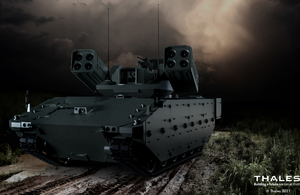Dstl unveils requirements for future anti-armour capabilities project
Dstl is working with the British Army, DE&S and industry partners to create the next generation of protection from armoured vehicles and other threats.

Image copyright Thales
Known as Battle Group Organic Anti-Armour (BGOAA), the work covers 4 areas:
- Close-In Self Defence (CISD): portable light weight munitions carried by Infantry sections
- Mounted Close Combat Overwatch (MCCO): a long range system providing anti-armour coverage to the battle group, with concepts carrying multiple missiles weighing up to 50kg with a range of up to 10km or more
- Close Combat Anti-Armour Weapons (CCAAW): Mounted and Dismounted, capable of destroying armoured vehicles even if hidden from view
The Land Weapons project aims to increase combat effectiveness by modernising the Army’s Guided Weapons that have been in service for over a decade. Using technology that can be launched at a greater distances and with increased force both outranging and overmatching the threat. A significant objective is to increase commonality and interchangeability between different platforms, providing greater flexibility and lower costs. Dstl is also exploring how such modular systems might enable launchers and missiles to be mounted across different trucks and armoured vehicles.
The new systems will incorporate a range of advanced technologies such as:
- Non line-of-sight capability
- Third-party/remote targeting and control
- New sensors to overcome ‘active protection systems’ and defeat the enemy’s electronic or electro-magnetic defences
The current focus is the development of the MCCO capability. Dstl is leading work with support from industry partners including Lockheed Martin, MBDA and Thales, generated through Dstl’s weapons sector framework contract. The long-range system will be capable of engaging targets up to 10km away with missiles weighing up to 50kg.
Dstl gave a presentation on the research to the media; find out more in Army Technology and Janes.